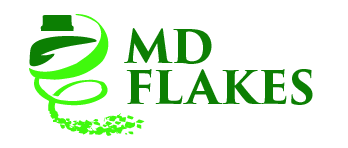05 September 2022
What do the logos of your packaging correspond to?
The logos of recycling are numerous and often green, but not always easy to understand or differentiate. Here is a little guide so that you can no longer be mistaken, but also know what you buy and how to throw it away.
GREEN POINT
Drunk logo if there is one, the green point absolutely does not indicate that the packaging on which it is found are recyclable. It simply means that the company that affixed it to its product pays a contribution to Citeo, an organization responsible for piloting sorting and recycling in France. Born in 1992 but a source of confusion, it should gradually disappear in favor of the Triman logo.
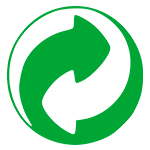
TRIMAN
Appearing in January 2015, this logo which displays a small character and three black arrows means that the packaging in question is recoverable, and can therefore be sorted. Relatively rare until some time ago, and visible only on the instructions for use of products or the websites of manufacturers, it should nevertheless become a standard in terms of household waste management and appear on all recyclable packaging from 2021. In any case, this is the wish of the current government.
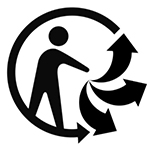
Info-Tri instructions
Whether it is plastic tracks to throw or cardboard packaging to sort and recycle, the info-TRI instructions are complementary to the greenery and Triman. Explicit, they simplify your life by specifying the destination of your waste, and encourage you to sort better and more. Established by Citeo (ex Eco-Emballages) in 2012, they are now affixed on more than 20 billion packaging.
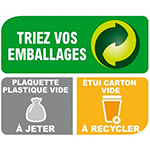
THE MÖBIUS RIBBON
Universal symbol of recycling since 1970, this representation of the infinity designed by the German mathematician August Ferdinand Möbius means that your packaging is recyclable.
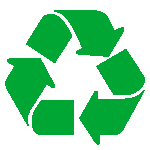
TIDY MAN
If this small pictogram gives you no information on the recyclable nature or not of your packaging, it nevertheless has the merit of being clear. His mission ? Simply encourage you to throw your packaging in a trash can, and not on the public highway. Because even this may seem obvious to you, it is always good to remember some basics.
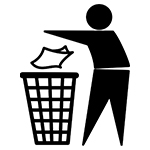
The barred trash
Warning: this pictogram does not mean that your used product should not be thrown away, but means that it cannot be thrown away in a traditional bin. It is thus found on certain types of waste, such as WEEE (Waste Electrical and Electronic Equipment), which must be sent to a specific collection point, or collected by an organization which will ensure its subsequent treatment. A service provided, moreover, by Easy Recyclage.
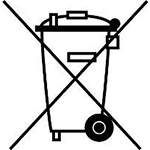
ALUMINUM, GLASS, STEEL LOGOS
A logo displaying a bottle surrounded by two arrows simply tells you that the glass is recoverable, and must therefore be thrown away in a specific container. The same goes for the symbols representing a magnet (a sign that your product has been designed with recyclable steel) or the word “alu” (for aluminium) surrounded by two arrows.
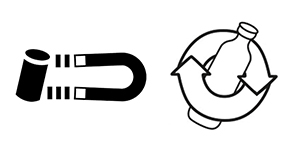
LOGOS PETE, PEHD, PP...
Beware of the three arrows that surround these mysterious symbols, they do not indicate that the plastic used to make the packaging is recyclable. The abbreviations, on the other hand, specify what type of plastic it is, and are graduated from 1 to 7 to represent the different families of materials. But note, however, that certain plastics such as PET (that of your water bottles) or HDPE (which is used to manufacture rigid containers) are perfectly recoverable and valued.
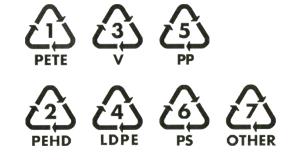
LOGOS PEFC, FSC
These are environmental certifications (which bear the names of the organizations responsible for delivering them) indicating that the paper, the cardboard or the wooden products on which they are found are manufactured by companies ensuring the sustainable management of forests.
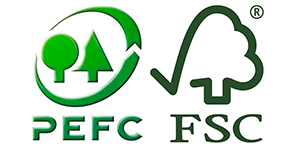
The paper logo
Like the green point, this acronym intended for paper products (press, directories, prospectuses, leaflets, etc.) tells you that their manufacturers have paid a contribution to an eco-organization. And once again is Citeo, born in 2017 of the merger between Eco-Emballages and Ecofolio, a structure responsible for making the link between all the actors in the paper sector in France.
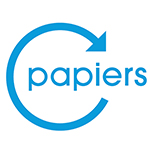
THE TETRA PAK LOGO
Bluer than the others, it tells you that your food brick – made of FSC-certified cardboard – is 100% recyclable.
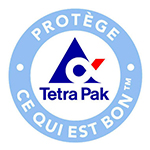
LOGO APUR
With its characteristic green leaf, this logo set up by the association of producers and users of recycled cardboard pappers indicates the percentage of recycled fibers used to make your product.
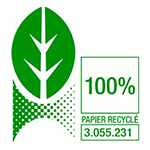
The Ecolabels logo
EU Ecolabel, NF Environnement, Der Blaue Engel (The Blue Angel): these logos mean that your products have been manufactured according to a very precise ecological specifications. Some of them (like Paper by Nature or the White Swan) more specifically indicate that your cardboard paper waste has been made with 75% recycled fibers.
So do not hesitate to put these new knowledge for tomorrow in your business. Papers, boxes, cans: a large part of the waste you produce can and must be recycled. And for others, solutions also exist. Easyrecyclage thus proposes-within a global sorting offer-a waste box devoted to non-this claimable materials. We invite you to join our teams for more information!
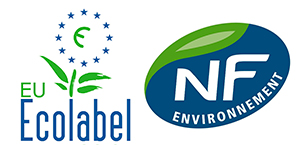
GREEN POINT
Drunk logo if there is one, the green point absolutely does not indicate that the packaging on which it is found are recyclable. It simply means that the company that affixed it to its product pays a contribution to Citeo, an organization responsible for piloting sorting and recycling in France. Born in 1992 but a source of confusion, it should gradually disappear in favor of the Triman logo.

TRIMAN
Appearing in January 2015, this logo which displays a small character and three black arrows means that the packaging in question is recoverable, and can therefore be sorted. Relatively rare until some time ago, and visible only on the instructions for use of products or the websites of manufacturers, it should nevertheless become a standard in terms of household waste management and appear on all recyclable packaging from 2021. In any case, this is the wish of the current government.

Info-Tri instructions
Whether it is plastic tracks to throw or cardboard packaging to sort and recycle, the info-TRI instructions are complementary to the greenery and Triman. Explicit, they simplify your life by specifying the destination of your waste, and encourage you to sort better and more. Established by Citeo (ex Eco-Emballages) in 2012, they are now affixed on more than 20 billion packaging.

THE MÖBIUS RIBBON
Universal symbol of recycling since 1970, this representation of the infinity designed by the German mathematician August Ferdinand Möbius means that your packaging is recyclable.

TIDY MAN
If this small pictogram gives you no information on the recyclable nature or not of your packaging, it nevertheless has the merit of being clear. His mission ? Simply encourage you to throw your packaging in a trash can, and not on the public highway. Because even this may seem obvious to you, it is always good to remember some basics.

The barred trash
Warning: this pictogram does not mean that your used product should not be thrown away, but means that it cannot be thrown away in a traditional bin. It is thus found on certain types of waste, such as WEEE (Waste Electrical and Electronic Equipment), which must be sent to a specific collection point, or collected by an organization which will ensure its subsequent treatment. A service provided, moreover, by Easy Recyclage.

ALUMINUM, GLASS, STEEL LOGOS
A logo displaying a bottle surrounded by two arrows simply tells you that the glass is recoverable, and must therefore be thrown away in a specific container. The same goes for the symbols representing a magnet (a sign that your product has been designed with recyclable steel) or the word “alu” (for aluminium) surrounded by two arrows.

LOGOS PETE, PEHD, PP...
Beware of the three arrows that surround these mysterious symbols, they do not indicate that the plastic used to make the packaging is recyclable. The abbreviations, on the other hand, specify what type of plastic it is, and are graduated from 1 to 7 to represent the different families of materials. But note, however, that certain plastics such as PET (that of your water bottles) or HDPE (which is used to manufacture rigid containers) are perfectly recoverable and valued.

LOGOS PEFC, FSC
These are environmental certifications (which bear the names of the organizations responsible for delivering them) indicating that the paper, the cardboard or the wooden products on which they are found are manufactured by companies ensuring the sustainable management of forests.

The paper logo
Like the green point, this acronym intended for paper products (press, directories, prospectuses, leaflets, etc.) tells you that their manufacturers have paid a contribution to an eco-organization. And once again is Citeo, born in 2017 of the merger between Eco-Emballages and Ecofolio, a structure responsible for making the link between all the actors in the paper sector in France.

THE TETRA PAK LOGO
Bluer than the others, it tells you that your food brick – made of FSC-certified cardboard – is 100% recyclable.

LOGO APUR
With its characteristic green leaf, this logo set up by the association of producers and users of recycled cardboard pappers indicates the percentage of recycled fibers used to make your product.

The Ecolabels logo
EU Ecolabel, NF Environnement, Der Blaue Engel (The Blue Angel): these logos mean that your products have been manufactured according to a very precise ecological specifications. Some of them (like Paper by Nature or the White Swan) more specifically indicate that your cardboard paper waste has been made with 75% recycled fibers.
So do not hesitate to put these new knowledge for tomorrow in your business. Papers, boxes, cans: a large part of the waste you produce can and must be recycled. And for others, solutions also exist. Easyrecyclage thus proposes-within a global sorting offer-a waste box devoted to non-this claimable materials. We invite you to join our teams for more information!

